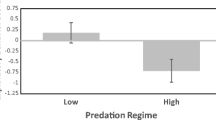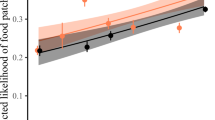Abstract
When animals forage in groups, they can search for food themselves (producer tactic), or they can search for opportunities to exploit the food discoveries of others (scrounger tactic). Both theoretical and empirical work have shown that group-level use of these alternative tactics is influenced by environmental conditions including group size and food distribution, and individual tactic use can be influenced by several measures of individual state, including body condition. Because body condition has been shown to be heritable for various species, social foraging tactics may also be heritable. We looked for evidence of heritability in social foraging tactic use in the zebra finch (Taeniopygia guttata) by testing whether: (1) natural variation in body condition correlates with tactic use, (2) there are family-related differences in body condition, and (3) there are family-related differences in observed tactic use. Tactic use in the zebra finch was significantly related to body condition; individuals with lower body condition scores had a significantly higher use of the scrounger tactic as predicted from variance-sensitive producer–scrounger models. Body-condition scores differed significantly between families, suggesting that this aspect of individual state may have a heritable component. Finally, we recorded significant family-related differences in the use of producer and scrounger alternatives. These results are consistent with heritability in observed tactic use resulting from an inheritance of individual state, in this case body condition, which itself influences tactic use. Understanding how and why individuals differ in their use of alternative tactics is fundamental as it may provide important insights into inter-individual variation in fitness.



Similar content being viewed by others
References
Barta Z, Giraldeau L-A (2000) Daily patterns of optimal producer and scrounger use under predation hazard: a state-dependent dynamic game analysis. Am Nat 155:570–582
Barta Z, Liker A, Mónus F (2004) The effects of predation risk on the use of social foraging tactics. Anim Behav 67:301–308
Beauchamp G (2001) Consistency and flexibility in the scrounging behaviour of zebra finches. Can J Zool 79:540–544
Beauchamp G (2006) Phenotypic correlates of scrounging behavior in zebra finches: role of foraging efficiency and dominance. Ethology 112:873–878
Blanckenhorn WU, Hosken DJ (2003) Heritability of three condition surrogates in the yellow dung fly. Behav Ecol 14:612–618
Boag DA, Alway JH (1981) Heritability of dominance status among Japanese quail: a preliminary report. Can J Zool 59:441–444
Coolen I (2002) Increasing foraging group size increases scrounger use and reduces searching efficiency in nutmeg mannikins (Lonchura punctulata). Behav Ecol Sociobiol 52:232–238
Coolen I, Giraldeau L-A (2003) Incompatibility between antipredatory vigilance and scrounger tactic in nutmeg mannikins, Lonchura punctulata. Anim Behav 66:657–664
Dall SRX, Witter MS (1998) Feeding interruptions, diurnal mass changes and daily routings of behaviour in the zebra finch. Anim Behav 55:715–725
Dall SRX, Johnstone RA (2002) Managing uncertainty: information and insurance under the risk of starvation. Philos Trans R Soc Lond B Biol Sci 357:1519–1526
Garant D, Dodson JJ, Bernatchez L (2003) Differential reproductive success and heritability of alternative reproductive tactics in wild Atlantic salmon (Salmo salar L.). Evolution 57:1133–1141
Giraldeau L-A, Caraco T (2000) Social foraging theory. Princeton University Press, Princeton, New Jersey
Gosler AG, Harper DGC (2000) Assessing the heritability of body condition in birds: a challenge exemplified by the great tit Parus major L. (Aves). Biol J Linn Soc 71:103–117
Green AJ (2001) Mass/length residuals: measures of body condition or generators of spurious results? Ecology 82:1473–1483
Gross MR, Repka J (1998a) Game theory and inheritance in the conditional strategy. In: Dugatkin LA, Reeve HK (eds) Game theory and animal behavior. Oxford University Press, New York, pp 168–187
Gross MR, Repka J (1998b) Stability with inheritance in the conditional strategy. J Theor Biol 192:445–453
Hazel WN, Smock R, Johnson MD (1990) A polygenic model for the evolution and maintenance of conditional strategies. Proc R Soc Biol Sci Ser B 242:181–187
Koops MA, Giraldeau L-A (1996) Producer–scrounger foraging games in starlings: a test of rate-maximizing and risk-sensitive models. Anim Behav 51:773–783
Lendvai ÁZ, Barta Z, Liker A, Bókony V (2004) The effect of energy reserves on social foraging: hungry sparrows scrounge more. Proc R Soc Biol Sci Ser B 271:2467–2472
Lendvai ÁZ, Liker A, Barta Z (2006) The effects of energy reserves and dominance on the use of social-foraging strategies in the house sparrow. Anim Behav 72:747–752
Liker A, Barta Z (2002) The effects of dominance on social foraging tactic use in house sparrows. Behaviour 139:1061–1076
Mathot KJ, Giraldeau L-A (2008) Increasing vulnerability to predation increases preference for the scrounger foraging tactic. Behav Ecol 19:131–138
Mathot KJ, Godde S, Careau V, Thomas DW, Giraldeau L-A (2009) Testing dynamic variance-sensitive foraging using individual differences in basal metabolic rates of zebra finches. Oikos 118:545–552
Merilä J, Kruuk LEB, Sheldon BC (2001) Natural selection on the genetic component of variance in body condition in a wild bird population. J Evol Biol 14:918–929
Morand-Ferron J, Giraldeau L-A, Lefebvre L (2007) Wild Carib grackles play a producer–scrounger game. Behav Ecol 18:916–921
Mottley K, Giraldeau L-A (2000) Experimental evidence that group foragers can converge on predicted producer–scrounger equilibria. Anim Behav 60:341–350
Pärt T (1990) Natal dispersal in the collared flycatcher: possible causes and reproductive consequences. Ornis Scand 21:83–88
Phillips RA, Furness RW (1998) Measurement of heritability of hatching date and chick condition in parasitic jaegers. Can J Zool 76:2290–2294
Pinheiro JC, Bates DM (2000) Mixed-effects models in S and S-PLUS. Springer Verlag, New York
Pinheiro JB, Bates D, DebRoy S, Sarkar D, R Core Team (2008) nlme: Linear and nonlinear mixed effects models. In: R package version 3.1–89
R Development Core Team (2007) R: A language and environment for statistical computing. R Foundation for Statistical Computing. In. See http://www.R-project.org, Vienna, Austria
Repka J, Gross MR (1995) The evolutionarily stable strategy under individual condition and tactic frequency. J Theor Biol 176:27–31
Rønning B, Jensen H, Moe B, Bech C (2007) Basal metabolic rate: heritability and genetic correlations with morphological traits in the zebra finch. J Evol Biol 20:1815–1822
Schulte-Hostedde AI, Zinner B, Millar JS, Hickling GJ (2005) Restitution of mass-size residuals: validating body condition indices. Ecology 86:155–163
Swain SD (1992) Flight muscle catabolism during overnight fasting in a passerine bird, Eremophila alpestris. J Comp Physiol B 162:383–392
Thériault V, Garant D, Bernatchez L, Dodson JJ (2007) Heritability of life-history tactics and genetic correlations with body size in a natural population of brook charr (Salvelinus fontinalis). J Evol Biol 20:2266–2277
Vickery WL, Giraldeau L-A, Templeton JJ, Kramer DL, Chapman CA (1991) Producers, scroungers, and group foraging. Am Nat 137:847–863
Wu G-M, Giraldeau L-A (2004) Risky decisions: a test of risk sensitivity in socially foraging flocks of Lonchura punctulata. Behav Ecol 16:8–14
Zann RA (1996) The zebra finch: a synthesis of field and laboratory studies. Oxford University Press, London
Zar JH (1999) Biostatistical analysis, 4th edn. Prentice Hall, Upper Saddle River
Acknowledgments
We are grateful to Neeltje Boogert for help with the breeding of the zebra finches, Jan Wijmenga for constructing the foraging grids and for comments on an earlier version of the MS, and Denis Réale and members of the Giraldeau lab for helpful discussions. KJM was supported by an Natural Sciences and Engineering Research Council of Canada (NSERC) graduate scholarship, an NSERC Discovery grant to L.-A.G, and a Bourse d'Excellence de l'UQAM.
Statement of integrity of research and reporting
These experiments conform to guidelines of the Canadian Council for Animal Care and were approved by the UQAM University Animal Care Committee (0108-601-0109). The authors declare that they have no conflict of interest.
Author information
Authors and Affiliations
Corresponding author
Additional information
Communicated by R. Gibson.
Rights and permissions
About this article
Cite this article
Mathot, K.J., Giraldeau, LA. Family-related differences in social foraging tactic use in the zebra finch (Taeniopygia guttata). Behav Ecol Sociobiol 64, 1805–1811 (2010). https://doi.org/10.1007/s00265-010-0992-2
Received:
Revised:
Accepted:
Published:
Issue Date:
DOI: https://doi.org/10.1007/s00265-010-0992-2




